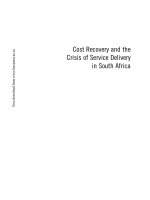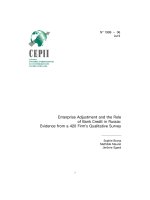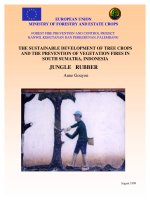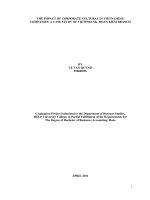UN-REDD programme and the progress of implementing REDD in Vietnam
Bạn đang xem bản rút gọn của tài liệu. Xem và tải ngay bản đầy đủ của tài liệu tại đây (121.47 KB, 6 trang )
MIDTERM EXAMINATION PAPER 2012 BY NGUYEN THANH TAN
UN-REDD programme and the progress of implementing REDD
in Vietnam
I was taught that the best way to have a deep understanding about something is
brainstorming your mind many ideas around it. Then I chose that way to present
my knowledge about the questions: What do you know about UN-REDD
programme? and What are the progresses of your country? The following
questions and answers about UN-REDD programme will show you the way it
works.
⌂About UN-REDD Programme:
What is REDD?
REDD stands for countries' efforts to Reduce Emissions from Deforestation and
forest Degradation.
REDD+ is similar to REDD, but instead of just covering deforestation and
degradation, it includes other activities, such as the sustainable management of
forests and the enhancement of forest carbon stocks.
UN-REDD programme is the United Nations' collaborative initiative on
Reducing Emissions from Deforestation and forest Degradation in developing
countries.
When was REDD established?
REDD was established during the 11th Convention of the Parties at the United
Nations Framework Convention on Climate Change that was held in Montreal,
Canada, in 2005.
Why do we need REDD+?
Because deforestation in tropical forests has gained salience in public debate on
climate change mitigation policies. Such salience stems from the negative
externalities caused by deforestation, such as the release of greenhouse gases
emissions, the loss of biomass, forest degradation etc. Recent research on CO2
emissions point out that tropical deforestation represents about 15 to 17 percent
of anthropogenic emissions of carbon dioxide (CO2).Without solutions for
deforestation, human will be face and bear with hundreds of disasters caused by
climate change. We need together act now and REDD is as a part of solutions.
How will REDD work?
The UN-REDD Programme supports nationally led REDD+ processes and
promotes the informed and meaningful involvement of all stakeholders,
including Indigenous Peoples and other forest-dependent communities, in
national and international REDD+ implementation. The Programme also works
1
MIDTERM EXAMINATION PAPER 2012 BY NGUYEN THANH TAN
to build international awareness and consensus about the importance of
including REDD+ mechanisms in a future climate change agreement.
The UN-REDD Programme is not the only initiative assisting countries that
wish to engage in REDD+ activities. Other initiatives include the World Bank’s
Forest Carbon Partnership Facility, Norway’s International Climate and Forest
Initiative, the Global Environment Facility, Australia’s International Forest
Carbon Initiative and the Collaborative Partnership on Forests.
In term of National programme, UN-REDD Programme assists developing
countries to prepare and implement national REDD+ strategies and mechanisms.
The actions help countries develop the capacity to implement REDD+ strategies
and become "REDD-readiness"; and provide practical experience and lessons
learned that could inform the international dialogue on a post-2012 REDD+
mechanism.
The UN-REDD in Developing Countries combines the efforts of three UN
Organizations: Food and Agriculture Organization of the United
Nations (FAO), United Nations Development Programme (UNDP) and United
Nations Environment Programme (UNEP) in supporting countries a variety of
donors, bilateral and multilateral alike.
Who get the paid on REDD?
The Programme currently has 46 partner countries spanning Africa, Asia-Pacific
and Latin America and the Caribbean. Sixteen of these countries are receiving
direct support to National Programmes. To-date, the UN-REDD Programme’s
Policy Board has approved a total of US$67.3 million for National Programmes
in these 16 partner countries. These funds help to support the development and
implementation of national REDD+ strategies. The remaining countries not
receiving direct support to national programmes engage with the Programme in
a number of ways, including as observers to the Programme's Policy Board, and
through participation in regional workshops and knowledge sharing, facilitated
by the Programme’s interactive online workspace.
What is progress of UN-REDD programme?
REDD+ activities are broken down into the following three phases:
• Phase 1: Development of national strategies or action plans, policies and
measures, and capacity building
• Phase 2: Implementation of national policies and measures and national
strategies or action plans that could involve further capacity building,
technology, development and transfer, and results-based demonstration
activities
• Phase 3: Results-based actions that should be fully measured, reported
and verified
The UN-REDD Programme is already active in phase 1 and has delivered
technical support and funding for the development of national REDD+ strategies
in pilot countries. While the phases are country-specific, and many countries are
likely to remain at phase 1 for some time yet, there is also a clear role for the
2
MIDTERM EXAMINATION PAPER 2012 BY NGUYEN THANH TAN
UN-REDD Programme in phase 2, in areas such as further capacity
development and policy and institutional strengthening.
⌂ About UN-REDD Vietnam Programme:
The question is just focus on the progress of implementing REDD in Vietnam,
but I would like to present briefly about some problems related to the progress in
Vietnam. I hope it will make my essay more convincing and clear.
Why choose Vietnam to test REDD mechanisms?
For a number of reasons, Vietnam has been selected as a test-case country by
donors such as the United Nations Collaborative Program on Reducing
Emissions from Deforestation and Forest Degradation in Developing Countries
(UN-REDD) and the World Bank's Forest Carbon Partnership Facility. Vietnam
is, given its long coastline and already pressured natural resources, one of the
most vulnerable countries to climate change. Vietnam is also an interesting case
for investigation owing to its rare trend of increasing forest cover. The per capita
emissions in Vietnam are only one third of the global average emission per
person; however, owing to rapid economic development emission from Vietnam
is increasing sharply compared with the rest of the world.
Who pay for the programme in Vietnam?
Being fully supported and executed by three UN agencies (UNDP, FAO,
UNEP), especially with financial and technical support from Norwegian
Government. After three years of implementation, the Government of Norway
has provided support of US$4.4 million to Vietnam in phase I. To date, program
has disbursed US$4.1 million. According to the agreement of the two
governments of Vietnam and Norway on the implementation of phase II,
Norwegian Government has also agreed to further sponsor Vietnam an amount
of US$30 million.
What is the progress of implementing REDD in Vietnam?
Since REDD became a major topic in international negotiations on climate
change since 2007, negotiators and observers have given much thought to
Vietnam. However, soon after the 13th Conference was held by the concerned
parties involving in the United Nations Framework Convention on Climate
Change on July 2007, Vietnam has become one of the first countries to express
interest in forest carbon partnership facility administered by World Bank with an
aim to supporting the development of national action plan on REDD +.Then the
UN-REDD Viet Nam Programme officially started in August 2009 and the first
phase was planned to complete by June 2012.
Currently, Vietnam has successfully implemented Vietnam UN-REDD
Programme Phase I, which was started in August 2009 at two pilot districts of
Lam Ha and Di Linh, Lam Dong province. Duration is 36 months from
September 2009 to September 2012. Funded by the Government of Norway,
3
MIDTERM EXAMINATION PAPER 2012 BY NGUYEN THANH TAN
Viet Nam’s US$4.38 million UN-REDD programme will be executed by the
Ministry of Agriculture and Rural Development (MARD), with the long-term
objectives are by the end of 2012 Vietnam is REDD-ready and able to contribute
to reducing emissions from deforestation and forest degradation in Vietnam and
in the region. In addition, to assist the Government of Vietnam in developing an
effective REDD regime in Viet Nam and to contribute to reduction of
greenhouse gas emission and climate change.
Through the Viet Nam REDD+ Office, the REDD Network and six very active
sub-technical working groups, a solid structural foundation has been put in place
at the national level for Viet Nam to move smoothly from Phase I to Phase II
activities for REDD+. This transition phase will focus on institutional
strengthening and capacity building in 40 provinces with abundant forests and
support pilot implementation of all the REDD activities + in 6 provinces as Bac
Kan, Ca Mau, Binh Thuan, Ha Tinh, Lam Dong. This phase is expected to last
until 2020.
What are the key achievements through REDD?
Over phase I, the Programme has made a significant impact on the domestic
forestry sector, in terms of policy and practice, and has been the most significant
initiative for REDD+ readiness in Viet Nam. It has achieved some notable
successes, when measured against its own objectives. For example, its work on
Benefit Distribution Systems began early and has generated important
discussions among forestry policy makers. In the pilot province of Lam Dong,
the pilot exercises on applying the principles of Free, Prior and Informed
Consent in the context of REDD+ were internationally recognized as
groundbreaking. The Programme also made a significant contribution to the
success of new multi-stakeholder bodies, such as the REDD Network and six
Sub-Technical Working Groups that contribute to research, development and
decision- making processes in REDD+ Readiness.
Which difficulties have been generating in the process of implementing
REDD?
In the process of implementation of REDD at site, we have met significant
challenges. The participation of the private sector is not strong enough
especially the companies working in the field of fisheries, agriculture related to
conversion of agricultural land. The awareness of REDD is different from the
central to local levels. There remains much limitation in coordination among
relevant agencies. On the legal basis, much needs to be done about Law on
Forest Protection in 2005 and carbon rights as well as the decentralization of
power to the Ministry of Agriculture and Rural Development and Ministry of
Natural Resources and Environment in the land allocation under Decree 99. The
goal of phase II is to finalize the legal framework to enable REDD + to realize
the intended objectives.
4
MIDTERM EXAMINATION PAPER 2012 BY NGUYEN THANH TAN
Today, we have another reason why we need to develop plantations and
sequester as much carbon as possible so that we mitigate climate change. We
have country lies with politicians, bureaucrats and academics. We have
manipulated the whole thing for our own selfish reasons because we are more
interested in the financial benefits of REDD rather than the social and
environmental benefits. Then now, the question is: In your opinion, how to
sustain the programme’s efficiency?
I think firstly, it is important to raise awareness for local people who have
unclear relationship with forests and lack collective rights to pre-existing
programmes. They should focus instead on a continuous, transparent and
equitable process of negotiation between local people and the initiators of
REDD+ activities. A more effective approach to grassroots engagement in
REDD+ is to concentrate on the more accessible concepts behind each of the
five REDD+ activities. Do not try to translate new terms but use familiar
vocabulary and local language as necessary. Communications under the UN-
REDD Programme should focus more on general information on REDD+ and
less on promotional literature for the Programme, in order to be of more long-
term utility for national stakeholders. The Programme also needs to build the
capacity of long-term staff, not only rely on temporary staff.
Potential problems with REDD+ should be more emphasized. The risk of
consent should be highlighted, as well as the importance of a recourse
mechanism. Communities should be able to report concerns and complaints to
agencies independent of local government. National endorsement of forest
certification systems may promote greater transparency and quality of the
information, as required for REDD+. The UN-REDD Programme should build
on the successful examples of previous multi-agency UN programmes. Finally,
financial flows and technical advice must be separate to achieve maximum
effectiveness.
If our hopes of building a better and safer world are to become more than
dreaming, we will need the engagement of volunteers more than ever.
REFERENCES
⌂ Related Information and Sources:
1. The UN-REDD Programme Strategy, 2011-2015, The United Nations Collaborative
Programme on Reducing Emissions from Deforestation and Forest Degradation in
Developing Countries.
2. Report of the UN-REDD Programme Fifth Policy Board Meeting, UN-REDD
PROGRAMME, 4-5 November 2010, Washington D.C., USA.
3. Assessing the Effectiveness of Training and Awareness Raising Activities of the UN-
REDD Programme in Viet Nam (2009-2011), UN-REDD PROGRAMME, June 2012.
4. REDD Readiness Progress Fact Sheet, COUNTRY: Vietnam, March, 2012.
5
MIDTERM EXAMINATION PAPER 2012 BY NGUYEN THANH TAN
5. Developing national REDD-plus systems: Progress challenges and ways forward, the
case of Indonesia and Vietnam country, September 2010.
⌂ Relevant Websites and Literature
1. About REDD, />2. EDF selected as representative to UN-REDD Program Policy Board,
/>redd-program-policy-board/
3. The Green Report UN REDD: Can the program save our tropical forests?,
/>program-save-our-tropical-forests.aspx
4. UN-REDD in Viet Nam, -
redd.org/UNREDDProgramme/CountryActions/VietNam/tabid/1025/language/en-
US/Default.aspx
5. National REDD strategy Vietnam, />redd-strategy-vietnam-presentation
6









